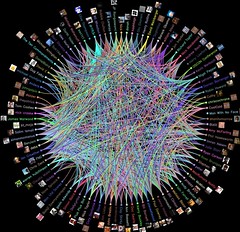Twittering for business
This post is about how companies should use Twitter.
I recently used a tool called Tweetwheel to create a visualisation of the people I follow on Twitter, and how they're connected. You can see a rough visualisation below, or click through here to get all the interactive goodness if you want:

So, no great surprise, it looks like a web.
And then I looked closer. I thought it might be interesting to work out how I knew these 109 people - here are the results:
But look. Two companies. That's it. I work for one and work closely with the second. There are several companies out there who are blogging and twittering; why aren't I following them?
Because it's like watching your Dad dancing at a wedding. When they do it, they get it wrong. It's embarrassing. As soon as a social activity has a profit motive, it stops being social.
And this just illustrates the pointlessness of companies having corporate twitter accounts (and this applies to corporate blogs too in most cases).
BUT....encouraging individuals in the companies to have blogs or twitter feeds; that's a different matter. I'm following lots of people who work for companies.
It's not just important; it's essential for large companies to encourage their employees to engage with customers and colleagues alike on public social networks. Its the only possible way to stay involved with the fast-moving, ever-changing social network landscape, especially across multiple countries, and demonstrate that you employ actual people behind the shiny facade of advertising.
So why maintain the Osmosoft twitter feed? Well, I think that small companies can just about get away with it. We have 71 people following this feed, about half of whom have a personal relationship with us. We have no branding guidelines, no tone of voice guidelines, no marketing plan, it's just one of us letting people know what's going on in a human voice. We don't have a company blog (choosing instead to point at our personal blogs) and this feed therefore acts as the main news outlet, which people can subscribe to or unsubscribe from as they wish.
So maybe we're the exception that proves the rule. Handy, eh? :-P
On a related note, I was surprised to note that there's only two people on the list that I knew before 2000! None of my friends from school, none of my friends from my flat-sharing and pub crawling days, none that I met while travelling, just one ex-colleague and my brother-in-law. In fact I've met all but five of my twitter contacts in the last four years. I wonder how common this is? I wonder what this says about me?
*includes members of the TiddlyWiki community not on BT's payroll (12 people)
I recently used a tool called Tweetwheel to create a visualisation of the people I follow on Twitter, and how they're connected. You can see a rough visualisation below, or click through here to get all the interactive goodness if you want:

So, no great surprise, it looks like a web.
And then I looked closer. I thought it might be interesting to work out how I knew these 109 people - here are the results:
- Current colleague or work contact * (43)
- Former colleague (21)
- Met at or through a conference (11)
- Read their book or blog (9)
- Humour / entertainment / News / Politics (18)
- Celebrity (2)
- Utilities (2)
- Companies (2)
- Family member (1)
But look. Two companies. That's it. I work for one and work closely with the second. There are several companies out there who are blogging and twittering; why aren't I following them?
Because it's like watching your Dad dancing at a wedding. When they do it, they get it wrong. It's embarrassing. As soon as a social activity has a profit motive, it stops being social.
And this just illustrates the pointlessness of companies having corporate twitter accounts (and this applies to corporate blogs too in most cases).
BUT....encouraging individuals in the companies to have blogs or twitter feeds; that's a different matter. I'm following lots of people who work for companies.
It's not just important; it's essential for large companies to encourage their employees to engage with customers and colleagues alike on public social networks. Its the only possible way to stay involved with the fast-moving, ever-changing social network landscape, especially across multiple countries, and demonstrate that you employ actual people behind the shiny facade of advertising.
So why maintain the Osmosoft twitter feed? Well, I think that small companies can just about get away with it. We have 71 people following this feed, about half of whom have a personal relationship with us. We have no branding guidelines, no tone of voice guidelines, no marketing plan, it's just one of us letting people know what's going on in a human voice. We don't have a company blog (choosing instead to point at our personal blogs) and this feed therefore acts as the main news outlet, which people can subscribe to or unsubscribe from as they wish.
So maybe we're the exception that proves the rule. Handy, eh? :-P
On a related note, I was surprised to note that there's only two people on the list that I knew before 2000! None of my friends from school, none of my friends from my flat-sharing and pub crawling days, none that I met while travelling, just one ex-colleague and my brother-in-law. In fact I've met all but five of my twitter contacts in the last four years. I wonder how common this is? I wonder what this says about me?
*includes members of the TiddlyWiki community not on BT's payroll (12 people)
Comments
> there's only two people on the
> list that I knew before 2000!
That's because twitter is like mobile phones in the 1980's.. only for toss-- er, I mean, people on the cutting edge.